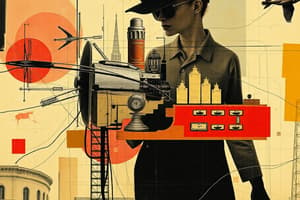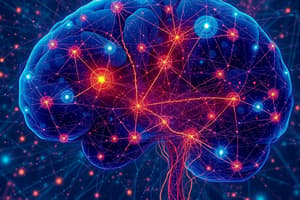Podcast
Questions and Answers
What role does efference copy play in the sensory system?
What role does efference copy play in the sensory system?
- It estimates expected sensory consequences based on past experiences. (correct)
- It only registers actual movements performed without predictions.
- It provides feedback about current sensory experiences.
- It solely regulates muscular activity without relation to sensory input.
What is the primary function of Golgi Tendon Organs (GTOs) in the context of proprioception?
What is the primary function of Golgi Tendon Organs (GTOs) in the context of proprioception?
- They provide a sense of body position relative to the environment.
- They generate signals related to efference copy mechanisms.
- They sense muscle force and provide awareness of muscular tension. (correct)
- They sense changes in joint angles during movement.
How does the comparison of expected and actual feedback assist in movement control?
How does the comparison of expected and actual feedback assist in movement control?
- It ensures there is no change in muscle tension during movement.
- It amplifies the sensation of sensory overload.
- It cancels out signals only when they are mismatched.
- It updates the body's computation of position when there is a mismatch. (correct)
What is a key aspect of internal models in sensory feedback?
What is a key aspect of internal models in sensory feedback?
Which statement accurately describes the effects of sensory prediction?
Which statement accurately describes the effects of sensory prediction?
What is the primary function of the efference copy?
What is the primary function of the efference copy?
Which joint receptors are most active during extension of the knee?
Which joint receptors are most active during extension of the knee?
What role do joint receptors play in proprioception?
What role do joint receptors play in proprioception?
How does joint swelling affect joint receptor activity?
How does joint swelling affect joint receptor activity?
Which statement about motor adaptation is true?
Which statement about motor adaptation is true?
What is the expected outcome of an efferent signal during movement?
What is the expected outcome of an efferent signal during movement?
How do Golgi-type endings contribute to proprioception?
How do Golgi-type endings contribute to proprioception?
What is the significance of the feed-forward model in sensory prediction?
What is the significance of the feed-forward model in sensory prediction?
What is the role of the efference copy in the sensory system?
What is the role of the efference copy in the sensory system?
How does proprioception affect the perception of weight over time?
How does proprioception affect the perception of weight over time?
What happens when a person performs a self-initiated tickle versus receiving an external tickle?
What happens when a person performs a self-initiated tickle versus receiving an external tickle?
What is the main purpose of internal models in movement?
What is the main purpose of internal models in movement?
Which factor causes a change in perception of effort during a weight-holding task?
Which factor causes a change in perception of effort during a weight-holding task?
What evidence supports the role of efference copy in sensory perception?
What evidence supports the role of efference copy in sensory perception?
What is a potential side effect of the efference copy during movement?
What is a potential side effect of the efference copy during movement?
How does the brain utilize feedback in conjunction with feedforward mechanisms during movement?
How does the brain utilize feedback in conjunction with feedforward mechanisms during movement?
Flashcards
Efference Copy
Efference Copy
A copy of a motor command sent to the muscles, used by the brain to predict the expected sensory consequences of that movement.
Proprioception
Proprioception
The sense of body position and movement.
Sensory Afferents
Sensory Afferents
Nerve signals that carry information from the body to the central nervous system (CNS).
GTOs (Golgi Tendon Organs)
GTOs (Golgi Tendon Organs)
Sensory receptors that detect muscle tension and protect muscles and joints from injury.
Signup and view all the flashcards
Joint Receptors
Joint Receptors
Sensory receptors that detect joint position and movement, protecting joints from damage.
Signup and view all the flashcards
Efference Copy
Efference Copy
A copy of a motor command sent to the muscles, used to predict the sensory feedback that will result from that movement.
Signup and view all the flashcards
Proprioception
Proprioception
Our sense of body position and movement.
Signup and view all the flashcards
Sensory Feedback
Sensory Feedback
Information about the environment and your body's position and movement, received from sensory receptors.
Signup and view all the flashcards
Internal Model
Internal Model
The brain's representation of how the body works and how movements affect the environment.
Signup and view all the flashcards
Feedforward
Feedforward
The system anticipates the outcome and prepares the body before an action (prior to feedback).
Signup and view all the flashcards
Feed-forward & feedback
Feed-forward & feedback
Combining prediction and feedback to refine movements.
Signup and view all the flashcards
Phantom Limb
Phantom Limb
The sensation that an amputated limb is still attached to the body.
Signup and view all the flashcards
Sense of Effort
Sense of Effort
The perceived amount of physical exertion required to perform a movement.
Signup and view all the flashcards
Joint Receptors
Joint Receptors
Sensory receptors in joints that respond to mechanical changes in position.
Signup and view all the flashcards
Proprioception
Proprioception
The sense of body position and movement.
Signup and view all the flashcards
Golgi-type endings
Golgi-type endings
A type of joint receptor sensitive to extreme joint positions.
Signup and view all the flashcards
Efferent movement
Efferent movement
Movement signaled through nervous system from the brain to body parts.
Signup and view all the flashcards
Efference Copy
Efference Copy
A prediction of the sensory signals resulting from movement.
Signup and view all the flashcards
Motor Commands
Motor Commands
Instructions from the brain to muscles for movement.
Signup and view all the flashcards
Joint Swelling
Joint Swelling
Inflammation or fluid buildup around a joint, affecting joint receptor sensitivity.
Signup and view all the flashcards
Movement Velocity
Movement Velocity
The speed at which a joint moves; more sensitive during higher movement speed.
Signup and view all the flashcardsStudy Notes
Motor Control (MC 3)
- Proprioception plays a key role in coordinating, guiding/adjusting movement, and producing skilled performance.
- The experience of the world comes from sensation.
- Week 3 lecture quiz is available on Canvas at 10 am post-lecture, closes at 8 am pre-lecture of Week 4.
- The quiz contains 3 Motor Control MCQs and 3 Motor Learning MCQs.
- Quizzes are aligned with learning outcomes.
- Two attempts per quiz; highest score recorded.
- Correct answers are visible after the quiz closes.
- Each quiz is worth 5% of the assessment (30 total points possible, 6 per quiz).
Sensory Proprioception
- Proprioception: A key role in coordinating, guiding/adjusting movement, and producing skilled performance.
- GTOs: Located in series between muscle fibers and tendons, they detect muscle tension (force).
- Muscle tension = tension in GTO
- GTO Reflex: Protects muscles and joints from excessive force.
- Joint Receptors: Activated by joint position changes, firing at any point in the range of motion.
- Contribute to proprioception and movement awareness.
- 4 main types: Golgi-Mazzoni corpuscles, Pacinian corpuscles, Ruffini endings, Golgi type endings, and free nerve endings. These vary in response to different aspects of joint movement.
- Examples of evidence: Physical movement across joint ranges increases the frequency of joint receptor signaling. Joint swelling leads to hyper-activity and sensitivity.
Efference Copy
- Efference copy: Internal copy of a motor command; includes movement prediction and resulting sensations.
- Hypothetical Function: Prepares sensory systems for upcoming motor command, with a reference for returning sensory signals from the peripheral system.
- Provides feed-forward sensory information and enables motor adaptation (movement adjustment).
- Enables CNS brain areas to alter, suppress or change subsequent responses/movements.
- Examples: Feeling textures without initial sensory cue, self-initiated tickles vs. external tickles.
- Side effects: Phantom limb in amputees, sense of effort, change in sense of effort in tasks like holding weight.
Sensory Input
- Sensory neural activity occurs in different modalities, crucial for movement control.
- Golgi Tendon Organs (GTOs): Sense muscle force; provide awareness of muscular tension and protect muscles and joints. Help regulate and coordinate muscular activity for proprioception.
- Joint Receptors: Provide awareness of joint position and potentially injurious flexion/extension.
- Efference Copy: Provides feed-forward sensory information about movement. Enables movement adjustment (motor adaptation) and alteration, suppression, or change of subsequent movements. It compares expected feedback with actual feedback, which allows for correcting any errors.
Studying That Suits You
Use AI to generate personalized quizzes and flashcards to suit your learning preferences.




